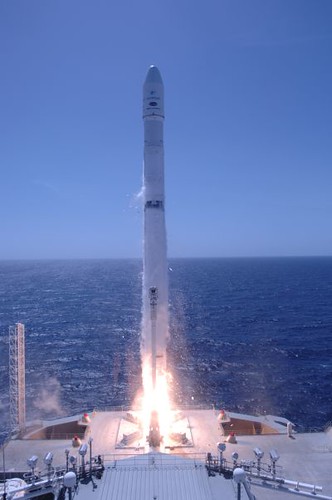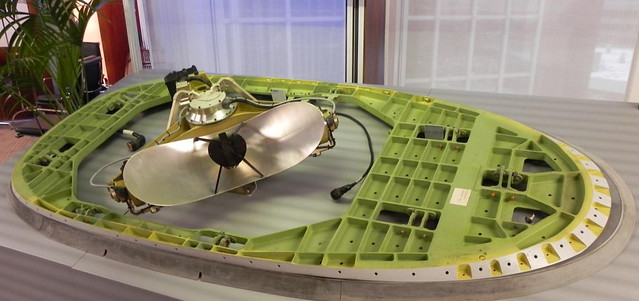In the satellite business, there’s a always a sense of excitement.
The competitive arena around choice orbitals slots. The suspense surrounding a launch campaign. Pushing the limits of new technology to get more out of what you already have.
Outside the industry, the general business public doesn’t fully understand it. For those of us inside the satellite business, being aware of the immense financial interests at stake on each of those complex systems, we can get worked up over the smallest success or failure, only without the drama.
It depends on what part of the business you’re working on.
We work in spacecraft propulsion systems: electric propulsion, to be specific. So you can imagine how we reacted two years ago, when we released news of our partnership with OHB Sweden, just as Boeing announced contracts to build two pair of all-electric spacecraft, one each for Satelitales Mexicano (Satmex) and Asia Broadcast Satellite (ABS).
This came soon after the U.S. Air Force and Aerospace Corp. saved the Advanced EHF spacecraft using electric propulsion. So we thought our timing was rather fortunate.
We’ve always admired Boeing for being typically at the forefront of new technologies in commercial space systems. And it’s been rather interesting to see how other manufacturers are responding. The ELECTRA project, a partnership with SES S.A. and European Space Agency, is one of the most noteworthy recent examples in developing a complete, all-electric propulsion platform.
Naturally, we’re very excited. We’ve seen the future and electric propulsion technologies will soon be at the core of in-space propulsion. This transformation will likely usher in a new era for satellite-based services by significantly expanding payloads aboard virtually any spacecraft.
We’re a small company and we’ve spent more than a decade developing electric propulsion systems and we think that soon the scene will be set for it to take center stage. Our breakthrough technology, the Electrodeless Ionization Magnetized Ponderomotive Acceleration Thruster (E-IMPAcT) is being brought to market on a solid foundation of more than 30 registered patents. Various testing in the U.S. and Europe have been very promising and we are approaching a new technological horizon. The interest we’ve received over the last couple of years has exceeded our expectations. Propulsion has a major impact on the entire economics of the satellite market and new solutions are rare.
Indeed, in many respects, the interest in electric propulsion for orbit-raising is logical and expected. Boeing’s 702SP bus is a real commercial endorsement of the critical advantages conferred by all electric propulsion and a prime example of future game-changing economics: more payload at less overall cost.
The Boeing spacecraft for Satmex and ABS, scheduled to launch in early 2015, are expected to weigh 1,800 kg and carry the same payload as some of the behemoths we’ve seen go up lately, thereby getting two spacecraft to launch on a Falcon 9 (or Ariane 5, just in case). Think about what this does for the design-build-launch side of the satellite business. Add the revenues associated with bigger payloads and the economic advantages are enormous.
There’s always risk in the space business. However, Boeing’s approach is only the beginning of this revolution. They spent a few years developing this propulsion system for the 702SP bus. However, one must consider the heritage this is built on top of — many years of experience with XIPS (xenon-ion propulsion system). Proven on-orbit technology is one of the most significant qualities customers looks for. This flown technology is being used in a new way, applied to medium-sized spacecraft after proving itself for station-keeping many times over.
On the orbit-raising aspect, flight-proven electric propulsion systems do take a long time to get the spacecraft to its useful service orbit. ESA’s Artemis took 18 months from the launch to its intended orbital location. That’s right: 18 months. The U.S. Air Force’s AEHF spacecraft needed 14 months to be salvaged by its electric propulsion system after its main chemical propulsion system failed.
That’s why we see opportunity for change in our industry, providing the technology for faster, higher-thrust, all-electric orbit-raising capability. We feel fortunate to have worked in electric propulsion for more than a decade and to now be at a point where we expect to meet the emerging and proven needs of the marketplace. We are but one company out of many in the space business who are continually looking for a better way to do things. These are the leaders with whom we identify – and the quiet, inherent enthusiasm we feel in our space business partners have for their work.
Seek out new technology. Embrace it and share your vision of what’s possible. The enthusiasm, competence and dedication I see every day is encouraging.
The new era in electric propulsion, of which Elwing hopes to be a part of, brings to mind a passage in Sir Arthur C. Clarke’s essay “Space and the Spirit of Man” (1965)…
“…we cannot predict the new forces, powers, and discoveries that will be disclosed to us when we reach the other planets or can set up new laboratories in space. They are as much beyond our vision today as fire or electricity would be beyond the imagination of a fish.”
Yet it now seems quite clear to many the future of in-space propulsion will indeed be electric propulsion technologies. Not that chemical propulsion is going away — there will still be many missions using it, but electric will swiftly become the mainstay, just as the rise of airplanes have not made all sea-faring vessels disappear. This evolution will certainly deeply reshuffle the global shares of the various space companies. It seems likely that the majority of satellite manufacturers will choose to no longer produce their own propulsion systems and rely instead on specialized industrial partners. Most importantly, this change in the root of the technology underlying all satellite services will probably change the entire industry, enabling new services and/or new players to emerge (think lower cost of bandwidth for sure, but also asteroid mining or satellite servicing which could not be viable without advanced propulsion).
The future will be electric, and it will be a much more diverse one. For the time being, no flight-proven electric technology to date is able to cover all the needs of all missions. Even as new technologies become available, the needs of satellite and space probe missions are diverse and call for diversified solutions. The future belongs to electric propulsion and it will greatly improve the space-based services we receive here on earth.
Gregory Emsellem
Chief Executive Officer
The Elwing Company
+1.310.308.3295
+33.601.82.15.27





